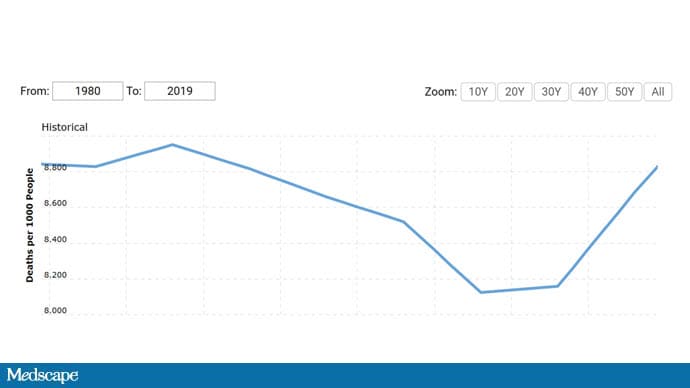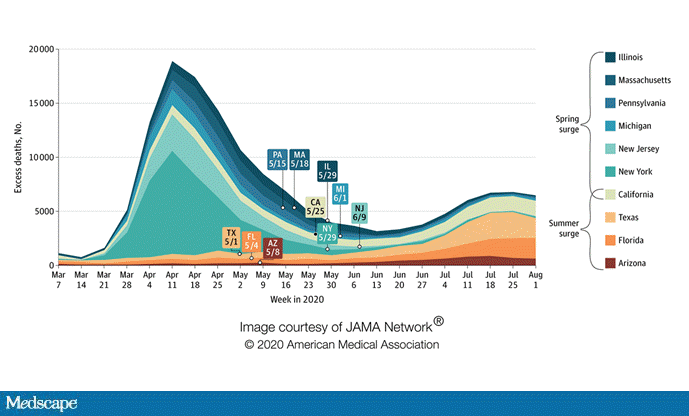Find the latest COVID-19 news and guidance in Medscape's Coronavirus Resource Center.
This transcript has been edited for clarity.
Welcome to Impact Factor, your weekly dose of commentary on a new medical study. I'm Dr F. Perry Wilson from the Yale School of Medicine.
I remember the first time I filled out a death certificate: Hospital of the University of Pennsylvania, medical ICU, 2006.
I'd been following the patient for about a week. He was an older man with heart disease and diabetes. He'd come in with pneumonia, developed severe sepsis, and finally had a cardiac arrest. It was the first time I ran a code, and obviously we didn't get him back. When it was over, my resident handed me a bunch of papers: the death certificate paperwork.
I had to list the cause of death. Was it the sepsis? The pneumonia? Or maybe the diabetes that predisposed him to it all? In the end, it felt somewhat arbitrary. A death is a death. I filled out the form, took a moment to process, and admitted the next patient.
A death is a death, regardless of the cause. And that's why, more than any other number in this pandemic, the "excess deaths" statistic is so compelling.
In a given year, deaths in the US, like most countries, are pretty stable.

Source: US Death Rate 1950-2020. Retrieved October 11, 2020.
They tend to rise a bit in the winter because of respiratory viruses, and they decline a bit in the spring and summer. But more or less, we know what to expect: around 8.5 deaths per 1000 people per year.
This year, from March to August, the death rate in the US was 9.8 per 1000 people per year. It may not seem like a big change, but this number is actually huge. In the time period of the coronavirus pandemic, we would have expected 1,111,000 deaths in this country. We got 1,337,000. That's 225,000 deaths more than expected, which, of course, is a bit more than the observed COVID death rate.
The observed-to-expected death rate is a great measure of how hard we are being hit by the pandemic. This statistic is a great equalizer; it doesn't rely on a robust COVID testing infrastructure or what appears on death certificates. A death is a death.
Two research letters appearing in JAMA this week leverage this statistic to compare how COVID has affected the US vs other countries, and states vs other states.
Let's start with a country-by-country comparison. This letter compares excess death rates in the US to other OECD [Organization for Economic Co-operation and Development] countries that capture data in a similar way.
Here I'm graphing for you the excess deaths per capita across a number of these countries. Blue are countries with moderate COVID mortality. Red is high COVID mortality. You can see that the US is on the high end but not the worst. We are outpaced at this point by the United Kingdom and Spain.

But the picture gets worse when you look at the epidemic over time. See, these high-mortality countries by and large brought their excess death rates down dramatically once they figured out how to best manage public health with COVID-19. Yes, that means masks, distancing, the stuff that works.
Look at the same data, but now examining excess deaths from May 10, 2020.

Across the board, excess death rates have declined significantly, even going negative in some places like Canada. But in this framework, the US has the dubious honor of being number one in excess deaths. The authors acknowledge that countrywide differences may play a role here; the US is younger in general but has more comorbidities. But, of course, they note that our lackluster public health response may also be to blame.
Looking at the variability in excess deaths, it's hard not to imagine what might have been. If the US had managed the pandemic like Norway or Germany, we could have 20,000 excess deaths right now instead of 225,000.
The other research letter helps us drill down into the states to see where these excess deaths are occurring.
There's an explanation for the disturbing trend here.

Woolf SH, et al. JAMA. Published online October 12, 2020. doi:10.1001/jama.2020.19545
You can see that early on in the pandemic, there was a really huge spike in excess deaths driven by states like New York, but those numbers dropped off quickly once those states got ahead of their epidemic curves. The ongoing excess deaths are driven by low but stubbornly elevated rates in states that saw cases rising over the summer. In a perverse way, it may be that this low but still elevated overall mortality rate is enough to fly below the public radar and decrease public pressure for public health solutions.
Now, I should mention that excess deaths and COVID deaths are not the same thing. These numbers include deaths from things like suicide, drug overdoses, and deferred care for non-COVID medical issues that have probably increased during the pandemic, and they of course would also reflect reduced deaths from things like traffic accidents that have gone down because of work-from-home policies and limitations on bars.
But as a number that has nothing to do with testing, nothing to do with how we fill out death certificates, excess deaths may be the best tool we have to compare the US response to the pandemic with other parts of the world. And, by this metric, it doesn't look good.
F. Perry Wilson, MD, MSCE, is an associate professor of medicine and director of Yale's Program of Applied Translational Research. His science communication work can be found in the Huffington Post, on NPR, and here on Medscape. He tweets @methodsmanmd and hosts a repository of his communication work at www.methodsman.com.
Follow Medscape on Facebook, Twitter, Instagram, and YouTube
Medscape © 2020 WebMD, LLC
Any views expressed above are the author's own and do not necessarily reflect the views of WebMD or Medscape.
Cite this: Excess COVID-19 Deaths: How Does the US Compare With Other Countries? - Medscape - Oct 13, 2020.









Comments